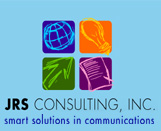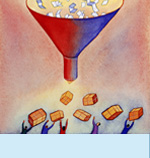To Ensure Marketing Success, Develop 20:20 Foresight
Research. Evaluation. These two terms often seem to go hand-in-hand. However, in my experience, when customer or employee input is sought only after a marketing program, it all too often becomes "justification" rather than "evaluation" because marketers then have a vested interest in supporting what's been done.
Have you ever considered that you might not have such a need for evaluation (or justification) if you had obtained input before embarking upon an initiative? If you have a clear picture of your customer and understand his or her needs when you're in the planning stage, you're much more likely to be "spot on" in the development of your products and services and in your marketing communications.
For example, a contact lens manufacturer, in the process of promoting its newly released colored contacts, asked us to help it understand how contact wearers viewed the new product. "Is this a fashion accessory? Is it something people try for fun? We need to know how wearers view the product before we can know what kinds of marketing tactics will be effective," said the marketing director.
In focus groups of women who had tried colored contact lenses, we probed:
How do you feel when you're wearing your regular contacts versus colored contacts?
What would you say to convince someone to try colored contacts?
Does wearing colored contacts remind you of anything else you do for your appearance?
The serious underlying tone of the responses surprised our client, who had envisioned positioning colored contacts as a fashion item.
"Eyes are a serious business. You don't want to mess around with your eyes. Why take a risk? It's important to have your doctor's support even if you're doing this for fashion."
"At first, I thought I wanted a dramatic change, but now I think of that as kind of a fad. I don't want people looking at me, trying to figure out if this is my eye color. I want to seem natural. I like to be noticed, but not too much."
"Colored contacts are okay if they enhance the natural color of your eyes. Then they're like wearing make-up. Bold color changes are for people who aren't quite sure who they are and want to try on different appearances. Those are the kind of people who get cosmetic surgery."
Safety... Enhancing a natural look... Not being noticed "too much..." Overall, the focus groups showed that associating colored contacts with feeling confident and comfortable was crucial for effective marketing. As a result of the focus groups, the contact lens marketing director could clearly see that positioning the lenses as strictly a fashion item would be a definite marketing "faux pas." Instead, he emerged from the research with a strategy of integrating the clinical side of colored contacts with fashion appeal.
The disparity between the manufacturer's perception of its customers' desires and what the customers truly wanted was striking. You may think that the example shared in this article is rare, but it is actually representative of what this kind of testing typically uncovers — the discrepancy between a company's perception of how its product is viewed and reality.
That's why this kind of research is non-negotiable. As the contact lens case study shows, getting customer input before launching marketing initiatives isn't a "nice to do" or "if time permits" or "if the budget allows" endeavor. It's a necessity to ensure the effective use of your marketing dollars.
The contact lens wearers sent a powerful message that applies to all marketing campaigns: Customers are not passive recipients of your message. In fact, customers are in complete control of how they receive what you have to say. They decide when and if they will give you their attention. They interpret their experience with you. They also determine whether they believe you and if your message is compelling.
The key to success is to tell your story in a way that is meaningful and that involves understanding your customer's perspective and needs before developing a marketing strategy and tactics. In other words, Develop 20-20 Foresight.
NEXT ARTICLE
Jenny Schade is president of JRS Consulting, Inc., a firm that helps organizations build leading brands and efficiently attract and motivate employees and customers. Subscribe to the free JRS newsletter on www.jrsconsulting.net/newsletter.html
© JRS Consulting, Inc. 2007





